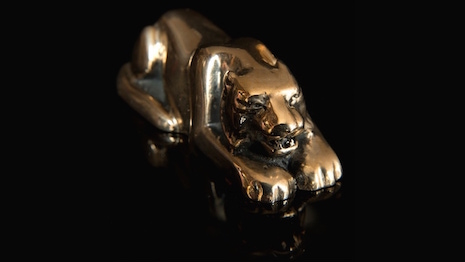British retailer Fortnum & Mason is partnering with artist David Bailey for a window installation that benefits an endangered species.
Mr. Bailey will create 400 small bronze tigers modeled after the real life Sumatran tiger, of which only 400 live in the wild today. Each piece will be available for sale with proceeds going to help conservation efforts of the specific subspecies of tiger.
Critically endangered species
The Sumatran tiger is native to Indonesia. As the smallest subspecies of tiger and facing threats from multiple angles both natural and man-made, only 400 Sumatran tigers survive in the wild today.
Mr. Bailey and Fortnum & Mason are working together to raise awareness and funds for the conservation of this species.
To do this, Mr. Bailey has created 400 small bronze tigers modeled after the Sumatran. They will be displayed in two windows in Fortnum & Mason in Piccadilly, London.
Each bronze tiger is on sale for £400, or $516 at current exchange rates, every cent of which will go to Greenpeace’s efforts to preserve the habitat of the Sumatran tiger.

Artist David Bailey
The tigers will be on display for 10 days, starting May 23. With each tiger sold, either in-store or online, it will be removed from the display in a demonstration of the terrible swiftness with which the real 400 tigers can disappear from the Earth if nothing is done to preserve the species.
Luxury brands and retailers have a unique opportunity to raise awareness for ecological goals due to their primary target demographic being wealthy and influential people. Other brands have already used this power, such as when Fragrance Du Bois collaborated on a song dedicated to sustainable wood harvesting.
The song, titled “Life’s Treasure,” was written to celebrate the dark, resinous heartwood commonly known as Oud or Agarwood that is a key ingredient in many perfumes and incense. Because Oud is in danger of becoming extinct, Fragrance Du Bois’ commitment to harvesting it in sustainable ways shows the brand’s dedication to protecting the environment (see story).
{"ct":"8Wxx24bUs+v2\/z7hdUUm8\/bXGjfJettVWqWsgIvdBr9GGMpKWRmNqFzbpu1mB3RAI\/kc8EtEHvkhCOkf7d903+8FVZNAHIlTiO0kVMDFRuwTn0zJRrq8wPWZz0Q398RFOFVKWT75w1tqd43RU9Nz28+8O1fTEqcfctk0YTddne05p\/qNf8qXUXspO6OvXAFnurKiMKPcCVk0gMMxtZz+C0R+g7Szf3gBZPd42m+B70sqLOcDd+++rmkNnwGB8APA5erBq2Uf3699fYTuA5L8iRIKV4lJBc2MFMdWk3ixKK7VsmdVi70mOd4\/Bjmm\/tf2ul3bHFWs5AzFEPQJZh+z3yFefzYycB3hKFYMzznKTn89wZ8YM6aA30YIrZLHmqDwQv6eXpoSjjo144FSzJ7JaFRTTf\/3b0g0n\/+iM3pqi\/YEwAFetVM\/6hN+PNUnCu1qP4tLZIEpyas4imhLQh6VEIskWmujdeT5SXbSQ9N5HQRcVwko1DGeVQWWWitQG0AOFMyacJg5l\/XZc+ySN1vSB5yKdcqas0aqISL4Xp7Ww4zqZTeOjcbjbOlA6EMiz1XHgI51LFekxPntHiDjrBdJlo2SYA\/YdA7BUJjex5WKtjYgsi3CgAwuwy2HtXz9LC2VQ9ByjmrMXxuK1OsrUP8Sod\/6l6GBCn7fz3EcT0R7BZPN7xURRH8zJjA+XHlswL9LMZ+cwdKVpGEaP8k45GSjAA46MqnmgHIP0N0W2\/nvqXEIa+Dlb5Mc+1creB1VEquzp9JW+jPkhSE9+BOcBNLArO3VdftBIADXCfymft1ceg5E6f+d+MUge55nkZ5fcpWI\/Qvmga3QmOu3mWz1SfrXGDtPC48kIFYBWmlgnwZz1RO3KlOYNrvDRpbDhd6OdBGaQ3anG7lKx7MXR0ZJKTrDeGSlOX8DrxKOAQE1kMVX5QZGHK0Np8eapLmNYUK0gVxnZNu8\/u2nXk1qIQOTKhNTjr81n9zFLaJHjwIC1uyQLUwgA0h8WAUdLxT3WOJK7Mumek6kaVruX4VHqiDM5YGqzCQZv561GGW9XetZuAsIFp970+ha6D7BO5R0UISWBn\/f8l4L1L5y8JQZUWZ5ru9ytuf6IV0DBotM3sSaCFmkRD\/ze+aAYqRWBt+hbK9lxFPLARzJpaMrLhMFGypYp1YDhmbosjHcRU1zOM0bPnb3YH1VjRShaX\/wB0klgh8R5WCJNmogrRCpDJEot0zJyqX6n5YLmXTmMTW4IPSt0iNoh1cZ6eumVYwC19xkIoQM5WPDa6SHd8zPW4syuXBd\/z1ZzlU5FhmgAnAOKZLIHz1X79jjjNtFVjfh9C7EKlHhfaccCl+jAq+SuSFiw7Z+gfg7vZgxXeQYhPsM2G88l6Q7o398BPDdosx5Nb9\/hsD4l1ZG\/FqooeYWTbklhxAJXFmpi5DjT\/4zN+1Ggr+J\/6gu7y1NIrUCsIMRYG+dZyL+849CtS1qYsT7KVIvWCF158q0QrQw5uMMzDND3hUzMGV7SvDtaB0URbH7qDcXM9dw5q9PgEyNF5IixsnXXqPdp7mFzgd\/gd4uvMe0j3ElMbQZ6XYB5yg\/llZ+qKCV\/AotBPxJhvN8jeo26H1g53VgZpjM8NJZg+qpprQqQBtVThXRnmzUJikgAQ51CtXY6pjSdcdFU87kUMUo1ysz\/8pJTyv7kDA8dQjUcZrxvjMEZsjbybgVrzKy6ylFnKZgcIBk9Z66LBUVxcwK2JltFiaLCfVEWB53rWrs\/IS\/zwBUvzylwGszX4wQQ2vwpqKRkLbHnh4YgMQ\/vtugmwdTImBBayNaBcxY1BR2cl6XpAQpURh4uNtBMu+aWU\/sNZNxWf8HVj7GAQ7VxjJWXtF2SP5O4lFpbXYa0QAUPnCPbgSmjakGsNQteX1w8ovybp8KFH++wDbqhCwZI2fsWHpUuVYqHwjIZ8ww3rxUKl7vYrqy8SJIYnZ3rWDNAFPJ5fFfjk\/51fS6v6X4p7PEZfzw755Tocrb+kFdLnALxj+KTwMUidWDlD4QjwajJfnUpiOjXGtRV0TVESoR8aOW4CsrJ8Rwge03yOGliraZe5ya9WnSu26tCkhUjjb4o12iXvMiKmfuLI4BUcq1vvC4RH6ntXAewEIZlY9VFxqRrjEYYm1tbH+Ey9huGY1YwggPIojvueeulQu8gOY8mNDnh\/rF\/PQqt7LACYQF7Tq1ySZSkCLTTx3vUH7o6BhCAGLMy0lWoBi5nIvt1PXxnoawBO+dXfGUBPKC1e4yAa74XphGbh2YV3Slw1RKLCnuIc6QpnapVHyNt7RJqoxGzZOl\/WBUOtt06RtaRNEQqLgxi08w63v1UhQEhDsDxwTk0CTYfFDxRa5R2Xdtq3I31JTuf2s2RkIhl4trGCPz37qpeDS5iZ8CFM1LicqBU0itytc8gonCaeukHon2zEk4\/zOBqAl+iWqn7KPLkDw9vUzrtTQaQcqS8LTRp7JQ2TMV3fEGMqlpstwqcBDGlLz8cKFufd76ZtBkmXJ5i96h9UYsLqrrFssv\/0+yKUYeulqsPg2uyj32xGataGD7bcwlrN+1JyhKU1uKUzfWJKkAoBqYSTKAXXlnR3E3lTRIK8X7BBvUAlnI3cm+x2xpVYYpQaIcEgD77z1\/wv2f9JUQUiifnJsKX9hbMujIFxL4Ax0AwUBWbXDlnAKqU2F5vpIGLajn6IxwtbpFccf4MwkA8Eikgdbg2UGJUAW\/d+bogF6UXtBWqo2oumG2BmticDbxpGo8BQGcKeZ+hz4vWbdCB3FMta1hkfuDyGENxn4Sa\/rBIJIq0kr6Qhh+Nld5G\/AxCb0GvZyOooxriulA6PfbZTf7xscie0x4CDc5IGslK2yjhz1OmnoBJj1xoG8RqTtjOOjXPwhtQCYvhiCRs0kV58lQhUcDeCOIu46pk34RAf2b0VAw0ROHgAzWwCi80D53bTHU9lolGPA+ZnD9b\/ufDJnBDu3ha\/PwvuQIR4d2LLW5blM+E\/JRQ+Ixq2vewXhPRDgqLw+O9tgICn2TxLb8BywT3KfpYrodflevDepJh0hYmpcMT9JgwC9IACB1fBjAXe8FyaI0oryD79odg4C2dj1OtF6oYcXPn+\/QtGkoVBlQaciZrishIrfuhi5hFKcpi73rFP+WCvgjym335+swbOjDpDVB\/OH4g0S5RseN46HY4WzK7r3DZx4vVmVndGlw+aCpaSamklZVchGw+eWRZa+j\/9oDyhhHvc4KE9GK4Ahk4wWKZNbw7ADvoTzuSFZnzFiH8Y+ZYiK+SMERm2DJOtrK2E1zcFkpO70\/4GDuQqH5jA13lmYo8G5uLg12tl\/xHaDl9WCgPNhC2jJeuMlMHlbrvu8S15OseM1DjR\/zRNdu50ySnXcpJppOWhWNQw1NrOkKH5liu2WlxTK2LF4AIzER4Nj816pgzygVvg\/bUrkS2jljEA3grrbBXSF+1YAwrh547kiIztpdE0ePm64rs0PrxVTG0yzup2dc2DnLnM+GRptPwUGkAwfaUPfDgQVO8NkRo49crBpiSD9GgWTUPg92eUPGJyk3NEBQVHIlCD9nzkOMFpdejM5jQxTWxSpFYqBD\/brpy+DOKGDzqTi7g4Xd\/99kk2txVru9DwW8UhWfuORPQLH3KPsilWaOfaa2ecUXQgYyMb2Q2FV+lgNXqqHSovmeaL1vmWowKb1igVFnPkkvt8AKUk\/i4GwWr11scm\/ThS6kA2KHpV85vw==","iv":"9ea5dcf5efebf4e58ffa3032b0692b83","s":"3793c978a47a1a9e"}

 Each of the 400 bronze tigers represents one of the real 400 Sumatran tigers alive today
Each of the 400 bronze tigers represents one of the real 400 Sumatran tigers alive today